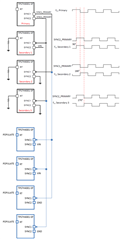I have a question on the SYNC1/SYNC2 pins on the TPS7H4001-SP: How many devices can these SYNC pins drive when operated in Primary Mode?
I’m considering operating 8 of these POLs either all individually, or in 4 groups of 2 in parallel, or in 2 groups of 4 in parallel. I’m looking to have all POL devices synchronized to the primary device to avoid any undesired input “beat frequency” noise. Leveraging Figure 7-6 from the datasheet, this would mean the SYNC pins wound need to drive upwards of 4 devices with 90° phase interleaving. With no phase interleaving, the number of devices the SYNC pin would need to drive is 7. I would like to know whether or not this is okay or if a buffer is needed.


